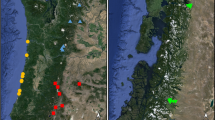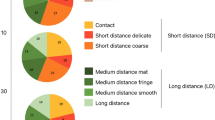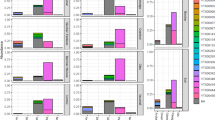Abstract
We discuss four potentially important interactions between mycorrhizal fungi and populations of plants. First, vesicular-arbuscular mycorrhizal colonization has been shown to increase reproduction (via both male and female functions) and offspring survival, and thus it can increase population size, at least in the short term. This is undoubtedly important to wild plant species and especially to those whose success depends on high rates of reproduction such as early successional annuals. Second, the positive response in growth and reproduction to vesicular-arbuscular mycorrhizal colonization may be inversely related to plant population density. All else being equal, this would tend to stabilize the density of natural plant populations over time. It may also explain why positive responses to mycorrhizal inoculation of dense crops are rare. Third, vesicular-arbuscular mycorrhizal fungi can increase inequality in size and reproduction among plants within a population. Mycorrhizal fungi may thus exaggerate the genetic overrepresentation in the next generation of the most robust individuals in the current generation. Fourth, established mycorrhizal plants may serve as important sources of inoculum for initially nonmycorrhizal, conspecific seedlings. This may affect regeneration, and could contribute to patchy distributions of species within the community.
Similar content being viewed by others
References
Abbott L K and Robson A D 1984 The effect of root density, inoculum placement and infectivity of inoculum on the development of vesicular-arbuscular mycorrhizas. New Phytol. 97, 285-299.
Allen M F 1987 Re-establishment of mycorrhizas on Mount St. Helens: Migration vectors. Trans. Br. Mycol. Soc. 88, 413-417.
Allsopp N and Stock W D 1992 Density dependent interactions between VA mycorrhizal fungi and even-aged seedlings of two perennial Fabaceae species. Oecologia 91, 281-287.
Barry D A J and Miller M H 1989 Phosphorus nutritional requirement of maize seedlings for maximum yield. Agronomy J 81, 95-99.
Bååth E and Hayman D S 1984 Effect of soil volume and plant density on mycorrhizal infection and growth response. Plant Soil 77, 373-376.
Bécard G and Piché Y 1989 Fungal growth stimulation by CO2 and root exudates in vesicular-arbuscular mycorrhizal symbiosis. Appl. Environ. Microbiol. 55, 2320-2325.
Begon M, Harper J L and Townsend C R 1986. Ecology, Individuals, Populations, and Communities. Sinauer Associates, Sunderland, MA, USA. 876 p.
Boswell E P, Koide R T, Shumway D L and Addy H D 1998. Winter wheat cover cropping, VA mycorrhizal fungi and maize growth and yield. Agric. Ecosys. Environ. 67, 55-65.
Bryla D R and Koide R T 1990a Regulation of reproduction in wild and cultivated Lycopersicon esculentum Mill. by vesiculararbuscular mycorrhizal infection. Oecologia 84, 74-81.
Bryla D R and Koide R T 1990b Role of mycorrhizal infection in the growth and reproduction of wild vs. cultivated plants. II. Eight wild accessions and two cultivars of Lycopersicon esculentum Mill. Oecologia 84, 82-92.
Carey P D, Fitter A H and Watkinson A R 1992 A field study using the fungicide benomyl to investigate the effect of mycorrhizal fungi on plant fitness. Oecologia 90, 550-555.
Dickie I A 2000. Mycorrhizal infection, nutrition, and growth of Quercus rubra L. seedlings as influenced by overstory trees on a disturbed forest site. Ph. D. Thesis, The Pennsylvania State University Intercollege Graduate Degree Program in Ecology.
Dickie I A, Koide R T and Fayish A C 2001 Vesicular-arbuscular mycorrhizal infection of Quercus rubra seedlings. New Phytol. 151, 257-264.
Dickie I A, Koide R T and Steiner K C Influence of established trees on mycorrhizas, nutrition, and growth of Quercus rubra seedlings. Ecol Monogr, in press.
Dodd J, Krikun J and Haas J 1983 Relative effectiveness of indigenous populations of vesicular-arbuscular mycorrhizal fungi from four sites in the Negev. Israel J. Bot. 32, 10-21.
Eissenstat D M and Newman E I 1990 Seedling establishment near large plants: Effects of vesicular-arbuscular mycorrhizas on the intensity of plant competition. Funct. Ecol. 4, 95-99.
Facelli E, Facelli J M, Smith S E and McLaughlin M J 1999 Interactive effects of arbuscular mycorrhizal symbiosis, intraspecific competition and resource availability on Trifolium subterraneum cv. Mt. Barker. New Phytol. 141, 535-547.
Finlay R D and Read D J 1986 The structure and function of the vegetative mycelium of ectomycorrhizal plants. II. The uptake and distribution of phosphorus by mycelium inter-connecting host plants. New Phytol. 103, 157-165.
Fitter A H 1989 The role and ecological significance of vesiculararbuscular mycorrhizas in temperate ecosystems. Agric. Ecosys. Environ. 29, 137-151.
Fitter A H 1991 Costs and benefits of mycorrhizas: Implications for functioning under natural conditions. Experientia 47, 350-355.
Fleming L V 1984 Effects of soil trenching and coring on the formation of ectomycorrhizas on birch seedlings grown around mature trees. New Phytol. 98, 143-153.
Gemma J N and Koske R E 1988 Pre-infection interactions between roots and the mycorrhizal fungus Gigaspora gigantean: Chemotropism of germ-tubes and root growth response. Trans. Br. Mycol. Soc. 91, 123-132.
Gibson F and Deacon J W 1988 Experimental study of establishment of ectomycorrhizas in different regions of birch root systems. Trans. Br. Mycol. Soc. 91, 239-251.
Grime J P, Mackey J M L, Hillier S H and Read D J 1987 Floristic diversity in a model system using experimental microcosms. Nature 328, 420-422.
Hartnett D C, Hetrick B A D, Wilson G W T and Gibson D J 1993 Mycorrhizal influence on intra-and interspecific neighbour interactions among co-occurring prairie grasses. J. Ecol. 81, 787-795.
Hayman D S 1983 The physiology of vesicular-arbuscular endomycorrhizal symbiosis. Can. J. Bot. 61, 944-963.
Heppell K B, Shumway D L and Koide R T 1998 The effect of mycorrhizal infection of Abutilon theophrasti on competitiveness of offspring. Funct. Ecol. 12, 171-175.
Jackson J F and Linskens H F 1982 Phytic acid in Petunia hybrida pollen is hydrolysed during germination by a phytase. Acta Bot. Neerlandica 31, 441-447.
Johnson N C, Tilman D and Wedin D 1992 Plant and soil controls on mycorrhizal fungal communities. Ecology 73, 2034-2042.
Kabir Z and Koide R T 2000 The effect of dandelion or a cover crop on mycorrhiza inoculum potential, soil aggregation and yield of maize. Agric. Ecosys. Environ. 78, 167-174.
Koide R T 1991a Density-dependent response to mycorrhizal infection in Abutilon theophrasti Medic. Oecologia 85, 389-395.
Koide R T 1991b Nutrient supply, nutrient demand and plant response to mycorrhizal infection. New Phytol. 117, 365-386.
Koide R T 2000 Mycorrhizal symbiosis and plant reproduction. In Arbuscular Mycorrhizas: Physiology and Function. Eds. Kapulnik Y and Douds D D Jr. pp. 19-46. Kluwer Academic Publishers, Dordrecht, The Netherlands.
Koide R T and Li M 1991 Mycorrhizal fungi and the nutrient ecology of three oldfield annual plant species. Oecologia 85, 403-412.
Koide R T, Li M, Lewis J and Irby C 1988 Role of mycorrhizal infection in the growth and reproduction of wild vs. cultivated plants. Oecologia 77, 537-543.
Koide R T and Lu X 1992 Mycorrhizal infection of wild oats: maternal effects on offspring growth and reproduction. Oecologia 90, 218-226.
Koide R T and Lu X 1995 On the cause of offspring superiority conferred by mycorrhizal infection of Abutilon theophrasti. New Phytol. 131, 435-441.
Koide R T, Shumway D L and Mabon S A 1994 Mycorrhizal fungi and reproduction of field populations of Abutilon theophrasti Medic. (Malvaceae). New Phytol. 126, 123-130.
Kranabetter J M and Wylie T T 1998 Ectomycorrhizal community structure across forest openings on naturally regenerated western hemlock seedlings. Can. J. Bot. 76, 189-196.
Last F T, Natarajan K, Mohan V and Mason P A 1992 Sequences of sheathing (ecto-) mycorrhizal fungi associated with man-made forests, temperate and tropical. In Mycorrhizas in Ecosystems. Eds. Read D J, Lewis D H, Fitter A H and Alexander I J. pp. 214-219. CAB International, Wallingford, UK.
Lewis J D and Koide R T 1990 Phosphorus supply, mycorrhizal infection and plant offspring vigour. Funct. Ecol. 4, 695-702.
Lu X and Koide R T 1991 Avena fatua L. seed and seedling nutrient dynamics as influenced by mycorrhizal infection of the maternal generation. Plant Cell Environ. 14, 931-939.
Lu X and Koide R T 1994 The effects of mycorrhizal infection on components of plant growth and reproduction. New Phytol. 128, 211-218.
Marx D H and Cordell C E 1987 Ecology and management of ectomycorrhizal fungi in regenerating forests in the eastern United States. In Mycorrhizae in the Next Decade: Practical Applications and Research Priorities. Eds Sylvia D M, Hung L L and Graham J H. pp. 69-71. Institute of food and agricultural sciences, University of Florida, Gainesville, FL, USA.
McGonigle T P 1988 A numerical analysis of published field trials with vesicular-arbuscular mycorrhizal fungi. Funct. Ecol. 2, 473-478.
McGonigle T P and Fitter AH 1990 Ecological specificity of vesicular-arbuscular mycorrhizal associations. Mycol. Res. 94, 120-122.
Moora M and Zobel M 1996 Effect of arbuscular mycorrhiza on inter-and intraspecific competition of two grassland species. Oecologia 108, 79-84.
Newman E I 1988 Mycorrhizal links between plants: their functioning and ecological significance. Adv. Ecol. Res. 18, 243-270.
Packer A and Clay K 2000 Soil pathogens and spatial patterns of seedling mortality in a temperate tree. Nature 404, 278-281.
Perry D A, Amaranthus M P, Borchers J G, Borchers S L and Brainerd R E 1989 Bootstrapping in ecosystems. BioScience 39, 230-237.
Pilz D P and Perry D A 1984 Impact of clearcutting and slash burning on ectomycorrhizal associations of Douglas-fir seedlings. Can. J. For. Res. 14: 94-100.
Poulton 2000 Effects of mycorrhizal infection and soil phosphorus availability on the male function of reproduction in Lycopersicon 317 esculentum Mill., PhD Dissertation, The Pennsylvania State University.
Poulton J L, Bryla D, Koide R T and Stephenson A G 2002 Effects of mycorrhizal infection and soil phosphorus availability on vegetative growth and the female and male functions in two cultivars of Lycopersicon esculentum. New Phytol. in press.
Poulton J L, Koide R T and Stephenson A G 2001a Effects of mycorrhizal infection and soil phosphorus availability on in vitro and in vivo pollen performance in Lycopersicon esculentum (Solanaceae). Am. J. Bot. 88, 1786-1793.
Poulton J L, Koide R T and Stephenson A G 2001b Effects of mycorrhizal infection, soil phosphorus availability, and fruit production on the male function in two cultivars of Lycopersicon esculentum Mill. Plant Cell Environ. 24, 841-849.
Raven P H 1979 Future directions in plant population biology. In Topics in Plant Population Biology. Eds. Solbrig O T, Jain S, Johnson G B and Raven P H. pp. 461-481. Columbia University Press, New York.
Robinson D and Fitter A H 1999 The magnitude and control of carbon transfer between plants linked by a common mycorrhizal network. J. Exp. Bot. 50, 9-13.
Shumway D L and Koide R T 1994a Reproductive responses to mycorrhizal colonization of Abutilon theophrasti Medic. plants grown for two generations in the field. New Phytol. 128, 219-224.
Shumway D L and Koide R T 1994b Within-season variability in mycorrhizal benefit to reproduction in Abutilon theophrasti Medic. Plant Cell Environ. 17, 821-827.
Shumway D L and Koide R T 1995 Size and reproductive inequality in mycorrhizal and nonmycorrhizal populations of Abutilon theophrasti. J. Ecol. 83, 613-620.
Simard S W, Perry D A, Smith J E and Molina R 1997 Effects of soil trenching on occurrence of ectomycorrhizas on Pseudotsuga menziesii seedlings grown in mature forests of Betula papyrifera and Pseudotsuga menziesii. New Phytol. 136, 327-340.
Smith S E and Dickson S 1991 Quantification of active vesiculararbuscular mycorrhizal infection using image analysis and other techniques. Aust. J. Plant Phys. 18, 637-648.
Smith S E and Read D J 1997 Mycorrhizal Symbiosis, second edition. Academic Press, San Diego. 605 p.
Solbrig O T 1981 Studies on the population biology of the genus Viola. II. The effect of plant size on fitness in Viola sororia. Evolution 35, 1080-1093.
St John T V, Hays R I and Reid C P P 1983 Influence of a volatile compound on formation of vesicular-arbuscular mycorrhizas. Trans. Br. Mycol. Soc. 81, 153-154.
Stanley M R, Koide R T and Shumway D L 1993 Mycorrhizal symbiosis increases growth, reproduction and recruitment of Abutilon theophrasti Medic. in the field. Oecologia 94, 30-35.
Stephenson A G, Erickson C W, Lau T-C, Quesada M R and Winsor J A 1994 Effects of growing conditions on the male gametophyte. In Pollen-Pistil Interactions and Pollen Tube Growth. Eds. Stephenson A G and Kao T H. Vol 12, pp. 220-229. Current Topics in Plant Physiology.
Terwilliger J and Pastor J 1999 Small mammals, ectomycorrhizae, and conifer succession in beaver meadows. Oikos 85, 83-94.
Trappe J M and Luoma D L 1992. The ties that bind: fungi in ecosystems. In The Fungal Community: Its Organization and Role in the Ecosystem, 2nd edn. Eds. Carroll G C and Wicklow D T.pp. 17-27. Marcel Dekker, New York.
Weiner J and Thomas S C 1986 Size variability and competition on plant monocultures. Oikos 47, 211-222.
Zhou M and Sharik T L 1997 Ectomycorrhizal associations of northern red oak (Quercus rubra) seedlings along an environmental gradient. Can. J. For. Res. 27, 1605-1713.
Zhou M, Sharik T L, Jurgensen M F and Richter D L 1997 Ectomycorrhizal colonization of Quercus rubra seedlings in response to vegetation removals in oak and pine stands. For. Ecol. Manag. 93, 91-99.
Author information
Authors and Affiliations
Corresponding author
Rights and permissions
About this article
Cite this article
Koide, R.T., Dickie, I.A. Effects of mycorrhizal fungi on plant populations. Plant and Soil 244, 307–317 (2002). https://doi.org/10.1023/A:1020204004844
Issue Date:
DOI: https://doi.org/10.1023/A:1020204004844




